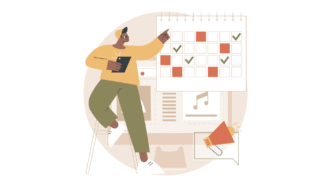LESSON OVERVIEW
The main objectives of this lesson are to:
- learn and practise useful language for meetings;
- talk about different meeting situations;
- role-play assigning tasks as company employees.
Students discuss what people talk about in meetings. They watch a short video, share their experiences with work meetings and think of topics people usually discuss in different types of meetings. Students also explore useful phrases for meetings (e.g. just to confirm, what do you mean by, you’re right, etc.) and role-play a situation where they are employees at a company discussing who does which task.
B1 / Intermediate75 minStandard LessonPremium Plan
WARM-UP AND DISCUSSION
This lesson where students learn useful language for meetings starts with a warm-up. Students watch a video on a team meeting and answer questions about what they think and their perspectives. Following that, they talk about their experiences with work meetings using some ideas (e.g. no meetings OR daily meetings, with a few people OR with many people, etc.). Afterwards, students look at types of meetings (weekly team meeting, one-to-one feedback meeting and meeting with a client) and think of topics people usually discuss in each of them. Next, they read statements about different types of meetings and decide which ones from the previous task they describe. Students also explain their opinions. After that, they read situations about communication experiences (e.g. a time you suggested an idea) and choose the ones that have happened to them during a meeting. Students share more details about them.
VOCABULARY AND ROLE-PLAY
At this point in the lesson, students fill in gaps in dialogues with useful language for meetings (e.g. Could you, How about, I can take care of that, etc.). After that, they read a dialogue where a team discusses a project and replace parts with useful phrases for meetings. Next, students imagine they are employees at a company and role-play two meetings with a partner. They decide who will do which tasks (e.g. send updates to a client, prepare the agenda for the next meeting, pick up documents at the post office, etc.), explaining why they can or can’t take on certain responsibilities. Students then switch the sets with phrases and discuss other tasks.
HOMEWORK/REVISION
This lesson plan also includes an additional task that you can use as homework or revision. In the task, students complete dialogues by choosing phrases for meetings and adding more details. The task is available in the teacher’s version of the worksheet. You can print it and hand it out to your students. It’s also included in the e-lesson plan.
WORKSHEETS
Subscribe to unlock these and many other Standalone lesson with the Premium plan
Subscribe











That’s a really useful one, thanks!
You’re welcome! Glad you found it helpful! 🙂
As a native British English speaker I’d usually follow ‘how about’ for making suggestions with the gerund form – e.g. “How about meeting next Tuesday.” or with a noun – e.g. “How about a cup of tea?” How about + present simple sounds more like American English to me.
Thank you for your comment! I think you’re absolutely right that “How about” + present simple probably originated in the US, but it does seem that both forms are now commonly used in British English, particularly in conversation. If students haven’t learned gerunds yet, the present simple form can definitely be an easier introduction.
Using the gerund or noun sounds a bit more formal and might be seen more often in written contexts, whereas the present simple feels more casual and conversational.
Please see two links that explore the usage of these phrases in both British and American English: here and here.
Hope this adds to the discussion!
Video doesn’t really go with the lesson.
The video is designed as a warm-up to set the right context for the lesson, however we’d love to hear more about your thoughts! Feel free to reach out to us at [email protected].
I love these type of speaking activites.
Great to hear that! Thank you 🙂